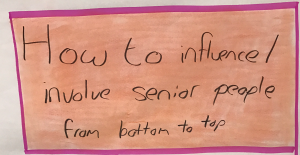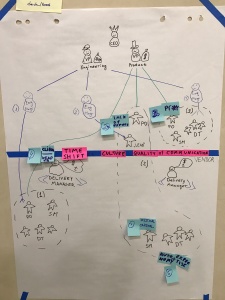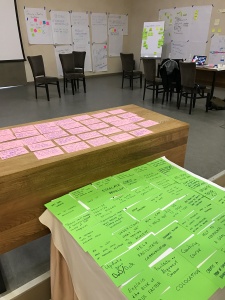Team Happy Seven
Vision was around how to influence people, specifically how to influence somebody perceive as more senior than you. Initially we expected our outcome to be a set of guidelines. Ultimately through our Sprints it turned into a coaching tool and set of guidelines that you could use when working with teams at any level.
more senior than you. Initially we expected our outcome to be a set of guidelines. Ultimately through our Sprints it turned into a coaching tool and set of guidelines that you could use when working with teams at any level.
The influencing poker tool and guidelines will be published here, when the first version is complete as the team continue to work on them.
Initial Scenario’s
Some of the team highlighted 3 scenario’s to think about when influencing up.

- Team influencing up in its own organisation. Team, Product Owner and ScrumMaster have a direct reporting line to the management internally.
- 3rd Party Development where the Product Owner and maybe a Delivery lead come from a client organisation but most of the team and ScrumMaster are from a 3rd Party supplier.
- Outsourcing model, where everything is outsourced to the supplier organisation, somebody acting in a Product Owner role is on the supplier side. More common when working with traditional client organisations.
The Tool
Influencing Poker can be played within Scrum Teams, Leadership Teams, Communities of Practice or any other associations of professionals that share interests and have problems in common.
There are a number of ways the tool can be played and we expect that you will adapt it to your context, we provide a few typical/recommended applications.
The Red cards represent challenges, of which you can also create your own. The green cards represent actives or plays that an organisation could implement to address certain challenges. So the tool is ideally used with people you want to influence, to drive conversation on a particular challenge the the organisation is facing, most importanly it should more them towards action.
How to Play the Game
- Evenly distribute the Green Solution cards amongst players
- A challenge is selected from the Red Challenge cards
- Each player chooses the best solution from their hand (or doesn’t play a card if none fit)
- The group prioritises/filters the solutions on the table
- The group may also suggest additional solutions that may work. For that, a new Green Solution card can be created “on-the-fly”.
- The group places the cards on the Influence Board influence board, to see what is within their sphere of control and what is not. in their “control” and what they can actually influence . Note: consider relabeling “Control vs. Influence’ to something like “Control (Immediate & Local) vs. Escalation (Global)
-
- If a group determines that Challenge is controllable/solvable locally (group level), it. The team selects the best a solution and makes it more specific to their context
- If a group determines that Challenge is NOT controllable/solvable locally (group level), and as such, is deemed as Global, it decides if Challenge should be trashed (if trivial) or escalated (if important enough).
- An action is assigned to 1 or more playerssomebody If Challenge is local, it is assigned to a person who will own it, solve it and visualize progress.
- Repeat if the team need to work on another challenge
This page will be updated as the guidelines evolve. The Cards and guidelines are coming soon.
The Team
The team included: Serhiy Lvov, Kiryl Baranoshnik, Artem Bykovets, Alexander Karitsky, Mark Summers, Jonas Mann and Gene Gendel .

